初中英语时态总结(较简单)
- 格式:doc
- 大小:63.00 KB
- 文档页数:8
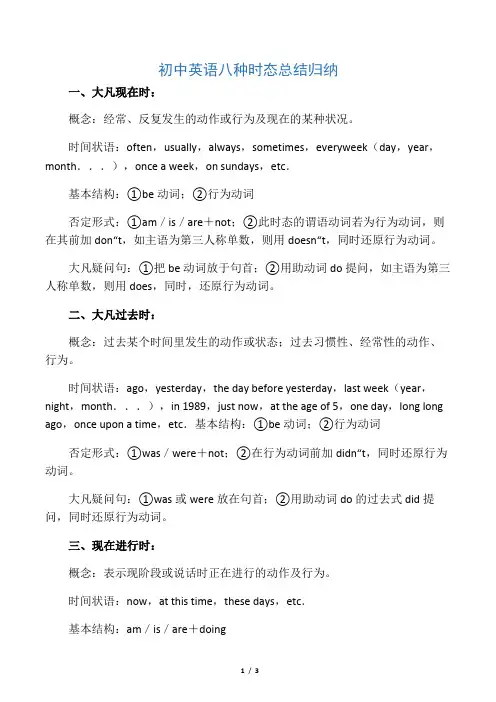
初中英语八种时态总结归纳一、大凡现在时:概念:经常、反复发生的动作或行为及现在的某种状况。
时间状语:often,usually,always,sometimes,everyweek(day,year,month...),once a week,on sundays,etc.基本结构:①be动词;②行为动词否定形式:①am/is/are+not;②此时态的谓语动词若为行为动词,则在其前加don“t,如主语为第三人称单数,则用doesn“t,同时还原行为动词。
大凡疑问句:①把be动词放于句首;②用助动词do提问,如主语为第三人称单数,则用does,同时,还原行为动词。
二、大凡过去时:概念:过去某个时间里发生的动作或状态;过去习惯性、经常性的动作、行为。
时间状语:ago,yesterday,the day before yesterday,last week(year,night,month...),in 1989,just now,at the age of 5,one day,long long ago,once upon a time,etc.基本结构:①be动词;②行为动词否定形式:①was/were+not;②在行为动词前加didn“t,同时还原行为动词。
大凡疑问句:①was或were放在句首;②用助动词do的过去式did提问,同时还原行为动词。
三、现在进行时:概念:表示现阶段或说话时正在进行的动作及行为。
时间状语:now,at this time,these days,etc.基本结构:am/is/are+doing否定形式:am/is/are+not+doing大凡疑问句:把be动词放在句首四、过去进行时:概念:表示过去某段时间或某一时刻正在发生或进行的行为或动作。
时间状语:at this time yesterday,at that time或以when引导的谓语动词是大凡过去时的时间状语等。
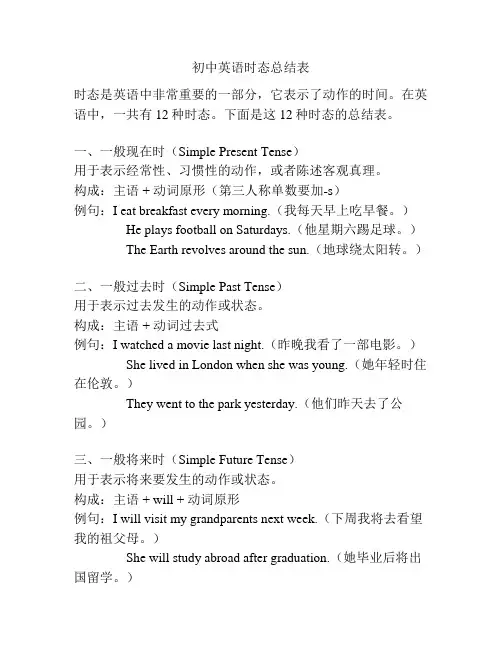
初中英语时态总结表时态是英语中非常重要的一部分,它表示了动作的时间。
在英语中,一共有12种时态。
下面是这12种时态的总结表。
一、一般现在时(Simple Present Tense)用于表示经常性、习惯性的动作,或者陈述客观真理。
构成:主语 + 动词原形(第三人称单数要加-s)例句:I eat breakfast every morning.(我每天早上吃早餐。
)He plays football on Saturdays.(他星期六踢足球。
)The Earth revolves around the sun.(地球绕太阳转。
)二、一般过去时(Simple Past Tense)用于表示过去发生的动作或状态。
构成:主语 + 动词过去式例句:I watched a movie last night.(昨晚我看了一部电影。
)She lived in London when she was young.(她年轻时住在伦敦。
)They went to the park yesterday.(他们昨天去了公园。
)三、一般将来时(Simple Future Tense)用于表示将来要发生的动作或状态。
构成:主语 + will + 动词原形例句:I will visit my grandparents next week.(下周我将去看望我的祖父母。
)She will study abroad after graduation.(她毕业后将出国留学。
)They will have a party on Friday.(他们将在星期五举行一个派对。
)四、现在进行时(Present Continuous Tense)用于表示现在正在进行的动作。
构成:主语 + am/is/are + 现在分词(-ing形式)例句:I am reading a book now.(我现在在读一本书。
)She is playing the piano at the moment.(她此刻正在弹钢琴。
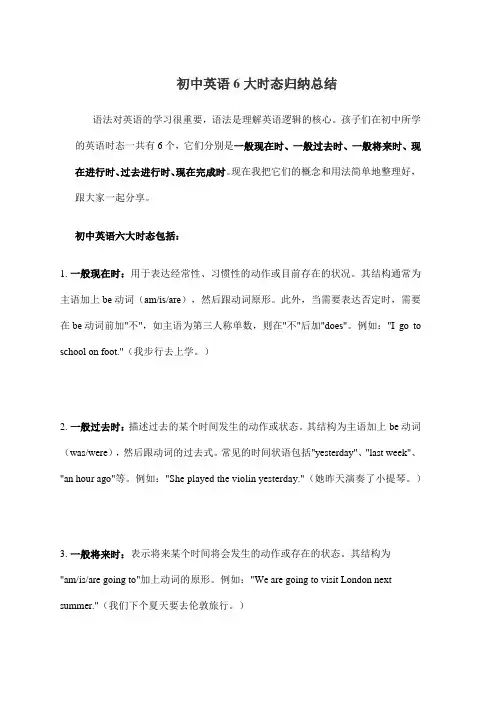
初中英语6大时态归纳总结语法对英语的学习很重要,语法是理解英语逻辑的核心。
孩子们在初中所学的英语时态一共有6个,它们分别是一般现在时、一般过去时、一般将来时、现在进行时、过去进行时、现在完成时。
现在我把它们的概念和用法简单地整理好,跟大家一起分享。
初中英语六大时态包括:1.一般现在时:用于表达经常性、习惯性的动作或目前存在的状况。
其结构通常为主语加上be动词(am/is/are),然后跟动词原形。
此外,当需要表达否定时,需要在be动词前加"不",如主语为第三人称单数,则在"不"后加"does"。
例如:"I go to school on foot."(我步行去上学。
)2.一般过去时:描述过去的某个时间发生的动作或状态。
其结构为主语加上be动词(was/were),然后跟动词的过去式。
常见的时间状语包括"yesterday"、"last week"、"an hour ago"等。
例如:"She played the violin yesterday."(她昨天演奏了小提琴。
)3.一般将来时:表示将来某个时间将会发生的动作或存在的状态。
其结构为"am/is/are going to"加上动词的原形。
例如:"We are going to visit London next summer."(我们下个夏天要去伦敦旅行。
)4.现在进行时:表示现阶段或说话时正在进行的动作及行为。
其结构为主语加上助动词"be"(am/are/is)加上动词的-ing形式。
例如:"She is listening to music."(她在听音乐。
)5.过去进行时:主要用来表示过去某一时刻或一段时间正在进行的动作或者存在的状态。
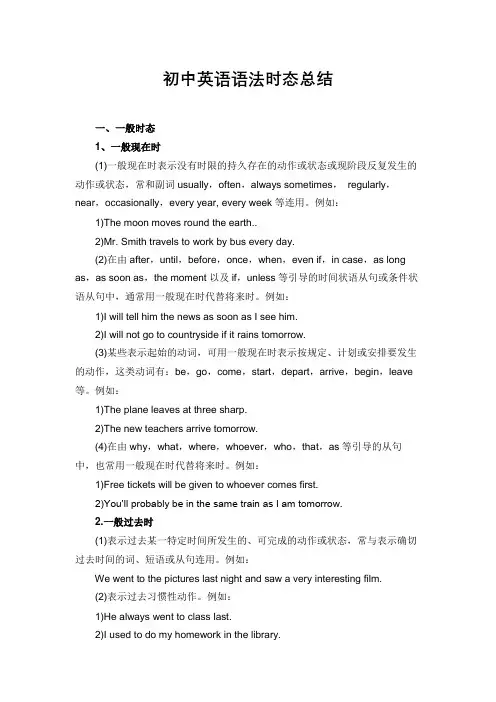
初中英语语法时态总结一、一般时态1、一般现在时(1)一般现在时表示没有时限的持久存在的动作或状态或现阶段反复发生的动作或状态,常和副词usually,often,always sometimes,regularly,near,occasionally,every year, every week等连用。
例如:1)The moon moves round the earth..2)Mr. Smith travels to work by bus every day.(2)在由after,until,before,once,when,even if,in case,as long as,as soon as,the moment以及if,unless等引导的时间状语从句或条件状语从句中,通常用一般现在时代替将来时。
例如:1)I will tell him the news as soon as I see him.2)I will not go to countryside if it rains tomorrow.(3)某些表示起始的动词,可用一般现在时表示按规定、计划或安排要发生的动作,这类动词有:be,go,come,start,depart,arrive,begin,leave 等。
例如:1)The plane leaves at three sharp.2)The new teachers arrive tomorrow.(4)在由why,what,where,whoever,who,that,as等引导的从句中,也常用一般现在时代替将来时。
例如:1)Free tickets will be given to whoever comes first.2)You’ll probably be in the same train as I am tomorrow.2.一般过去时(1)表示过去某一特定时间所发生的、可完成的动作或状态,常与表示确切过去时间的词、短语或从句连用。

初中英语八种时态归纳总结Newly compiled on November 23, 2020初中英语八种时态归纳总结时态是英语学习中一个至关重要的内容,初中学生在实际运用时,往往对时态总是倍感棘手,下面我们就归纳一下这几种时态。
一、一般现在时:概念:经常、反复发生的动作或行为及现在的某种状况。
时间状语:always, usually, often, sometimes, every week (day, year, month…), once a week, on Sundays, etc.基本结构:①主语 + be动词 + 其他;②主语 + 行为动词 + 其他否定形式:①主语 + am/is/are + not + 其他;②此时态的谓语动词若为行为动词,则在其前加don't,主语为第三人称单数,则用doesn't,同时还原行为动词。
一般疑问句:①把be动词放于句首;②用助动词do提问,如主语为第三人称单数,则用does,同时还原行为动词。
二、一般过去时:概念:过去某个时间里发生的动作或状态;过去习惯性、经常性的动作、行为。
时间状语:ago, yesterday, the day before yesterday, last week(year, night, month…), in 1989, just now, at the age of 5, one day, long long ago, once upon a time, etc.基本结构:①主语 + be动词 + 其他;②主语 + 行为动词 + 其他否定形式:①主语 + was/were + not + 其他;②在行为动词前加didn't,同时还原行为动词。
一般疑问句:①was或were放于句首;②用助动词do的过去式did 提问,同时还原行为动词。
三、现在进行时:概念:表示现阶段或说话时正在进行的动作及行为。
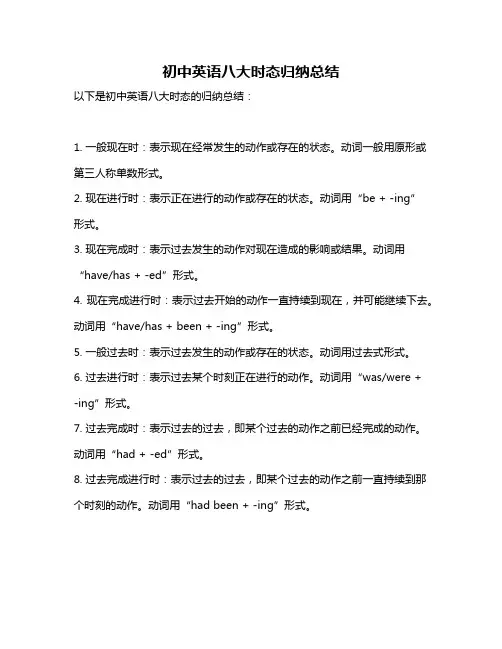
初中英语八大时态归纳总结
以下是初中英语八大时态的归纳总结:
1. 一般现在时:表示现在经常发生的动作或存在的状态。
动词一般用原形或第三人称单数形式。
2. 现在进行时:表示正在进行的动作或存在的状态。
动词用“be + -ing”
形式。
3. 现在完成时:表示过去发生的动作对现在造成的影响或结果。
动词用“have/has + -ed”形式。
4. 现在完成进行时:表示过去开始的动作一直持续到现在,并可能继续下去。
动词用“have/has + been + -ing”形式。
5. 一般过去时:表示过去发生的动作或存在的状态。
动词用过去式形式。
6. 过去进行时:表示过去某个时刻正在进行的动作。
动词用“was/were + -ing”形式。
7. 过去完成时:表示过去的过去,即某个过去的动作之前已经完成的动作。
动词用“had + -ed”形式。
8. 过去完成进行时:表示过去的过去,即某个过去的动作之前一直持续到那个时刻的动作。
动词用“had been + -ing”形式。
以上是初中英语的八大时态,理解和掌握这些时态对于英语学习和交流非常重要。
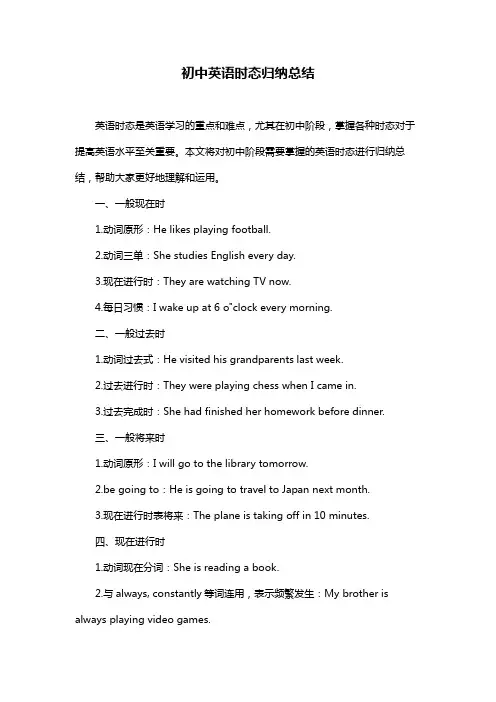
初中英语时态归纳总结英语时态是英语学习的重点和难点,尤其在初中阶段,掌握各种时态对于提高英语水平至关重要。
本文将对初中阶段需要掌握的英语时态进行归纳总结,帮助大家更好地理解和运用。
一、一般现在时1.动词原形:He likes playing football.2.动词三单:She studies English every day.3.现在进行时:They are watching TV now.4.每日习惯:I wake up at 6 o"clock every morning.二、一般过去时1.动词过去式:He visited his grandparents last week.2.过去进行时:They were playing chess when I came in.3.过去完成时:She had finished her homework before dinner.三、一般将来时1.动词原形:I will go to the library tomorrow.2.be going to:He is going to travel to Japan next month.3.现在进行时表将来:The plane is taking off in 10 minutes.四、现在进行时1.动词现在分词:She is reading a book.2.与always, constantly等词连用,表示频繁发生:My brother is always playing video games.五、过去进行时1.动词过去分词:They were discussing the project.2.与at that time, at this moment等词连用,表示在某个时间正在进行的动作:At that time, she was sleeping.六、完成时1.现在完成时:I have finished my homework.2.过去完成时:He had left the classroom before I arrived.七、被动语态1.一般现在时:The book is written by him.2.一般过去时:The window was broken by Tom.3.一般将来时:The letter will be sent to her tomorrow.总结:初中英语时态的学习需要掌握一般现在时、一般过去时、一般将来时、现在进行时、过去进行时、完成时和被动语态等。
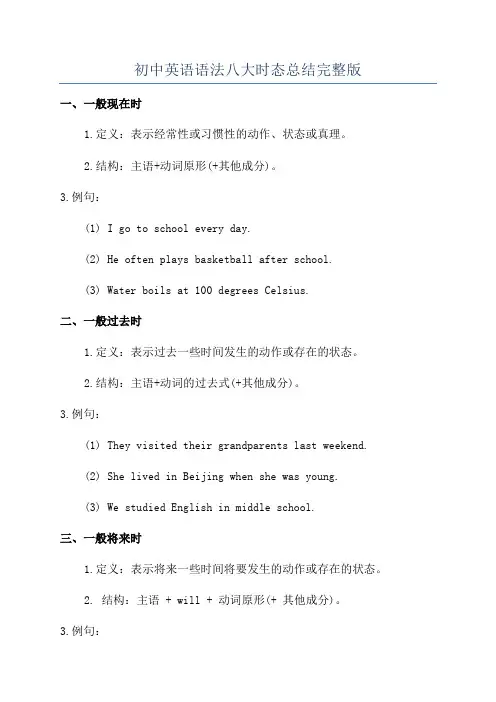
初中英语语法八大时态总结完整版一、一般现在时1.定义:表示经常性或习惯性的动作、状态或真理。
2.结构:主语+动词原形(+其他成分)。
3.例句:(1) I go to school every day.(2) He often plays basketball after school.(3) Water boils at 100 degrees Celsius.二、一般过去时1.定义:表示过去一些时间发生的动作或存在的状态。
2.结构:主语+动词的过去式(+其他成分)。
3.例句:(1) They visited their grandparents last weekend.(2) She lived in Beijing when she was young.(3) We studied English in middle school.三、一般将来时1.定义:表示将来一些时间将要发生的动作或存在的状态。
2. 结构:主语 + will + 动词原形(+ 其他成分)。
3.例句:(1) I will go to the park tomorrow.(3) We will have a party next week.四、现在进行时1.定义:表示现在正在进行的动作。
2. 结构:主语 + am/is/are + 动词-ing(+ 其他成分)。
3.例句:(1) She is reading a book right now.(2) They are playing soccer in the park.(3) We are having dinner at the moment.五、过去进行时1.定义:表示过去一些时间正在进行的动作。
2. 结构:主语 + was/were + 动词-ing(+ 其他成分)。
3.例句:(1) He was watching TV at 8 o'clock last night.(2) They were traveling in Europe during summer vacation.(3) We were studying when the phone rang.六、将来进行时1.定义:表示将来一些时间正在进行的动作。
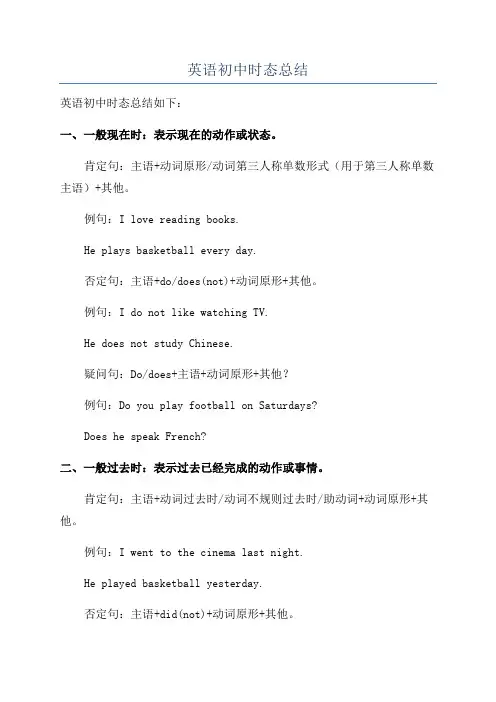
英语初中时态总结英语初中时态总结如下:一、一般现在时:表示现在的动作或状态。
肯定句:主语+动词原形/动词第三人称单数形式(用于第三人称单数主语)+其他。
例句:I love reading books.He plays basketball every day.否定句:主语+do/does(not)+动词原形+其他。
例句:I do not like watching TV.He does not study Chinese.疑问句:Do/does+主语+动词原形+其他?例句:Do you play football on Saturdays?Does he speak French?二、一般过去时:表示过去已经完成的动作或事情。
肯定句:主语+动词过去时/动词不规则过去时/助动词+动词原形+其他。
例句:I went to the cinema last night.He played basketball yesterday.否定句:主语+did(not)+动词原形+其他。
例句:I did not like the movie.He did not watch TV last night.疑问句:Did+主语+动词原形+其他?例句:Did you go to the party last night?Did he play basketball yesterday?三、现在进行时:表示现在正在进行或进行的动作。
肯定句:主语+be(am/is/are)+动词现在分词+其他。
例句:I am reading a book.He is playing basketball.否定句:主语+be(am/is/are(not))+动词现在分词+其他。
例句:I am not watching TV.He is not studying Chinese.疑问句:Be(am/is/are)+主语+动词现在分词+其他?例句:Are you playing football?Is he speaking French?四、过去进行时:表示过去一段时间内正在进行的动作。
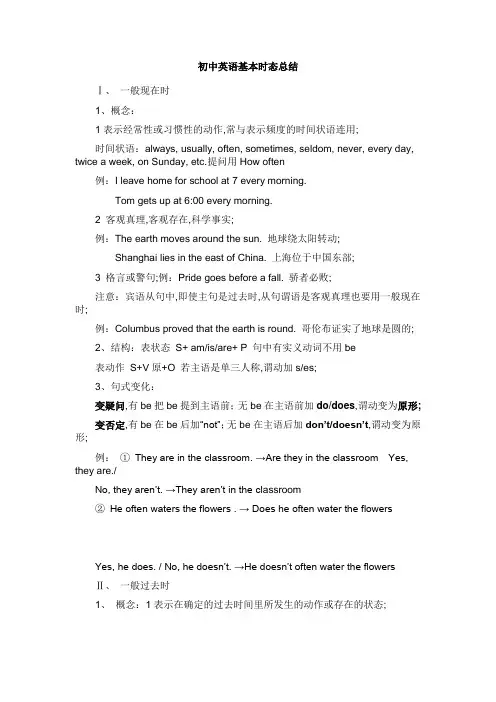
初中英语基本时态总结Ⅰ、一般现在时1、概念:1表示经常性或习惯性的动作,常与表示频度的时间状语连用;时间状语:always, usually, often, sometimes, seldom, never, every day, twice a week, on Sunday, etc.提问用How often例:I leave home for school at 7 every morning.Tom gets up at 6:00 every morning.2 客观真理,客观存在,科学事实;例:The earth moves around the sun. 地球绕太阳转动;Shanghai lies in the east of China. 上海位于中国东部;3 格言或警句;例:Pride goes before a fall. 骄者必败;注意:宾语从句中,即使主句是过去时,从句谓语是客观真理也要用一般现在时;例:Columbus proved that the earth is round. 哥伦布证实了地球是圆的;2、结构:表状态S+ am/is/are+ P 句中有实义动词不用be表动作S+V原+O 若主语是单三人称,谓动加s/es;3、句式变化:变疑问,有be把be提到主语前;无be在主语前加do/does,谓动变为原形;变否定,有be在be后加“not”;无be在主语后加don’t/doesn’t,谓动变为原形;例:①They are in the classroom. →Are they in the classroom Yes, they are./No, they aren’t. →They aren’t in the cl assroom②He often waters the flowers . → Does he often water the flowersYes, he does. / No, he doesn’t. →He doesn’t often water the flowersⅡ、一般过去时1、概念:1表示在确定的过去时间里所发生的动作或存在的状态;常用时间状语:yesterday, the day before yesterday, last week, just now, an hour ago, the other day, in 1982. at the age of 5, one day, long long ago, etc.例:Where did you go just now2表示在过去一段时间内,经常性或习惯性的动作;例:When I was a child, I often played football in the street.2、结构:表状态S+ was/were+ P表动作S+V过去式+O 注:句中有实义动词不用be3、句式变化:变疑问,有be把be提到主语前;无be在主语前加did,谓动变为原形;变否定,有be在be后直接加“not”;无be在主语后加didn’t,谓动变为原形.例:①She was in Xi’an last month. → Was she in Xi’an last monthYes, she was. /No, she wasn’t. →She wasn’t in Xi’an last month.②Danny grew a rose just now, → Did Danny grow a rose just nowYes, he did. / No, he didn’t. →Danny didn’t grow a rose just now,Ⅲ、现在进行时:1. 概念:表示现阶段或说话时正在进行的动作;时间状语:now, at this time, these days,以及有look, listen时;例:ListenThe birds are singing.2、结构:S + am/is/are + doing助动现在分词3、句式变化:变疑问,把am/is/are提到主语前;变否定,在am/is/are后直接加“not”;例:①I am writing a letter now. → Are you writing a letter nowYes, I am. /No, I’m not. →I am not writing a letter now. 注:am和not不能缩写;②The boys are playing football. → Are the boys playing footballYes, they are. / No, they aren’t. →The boys aren’t playing football.Ⅳ、过去进行时:1. 概念:表示过去某段时间或某一时刻正在发生或进行的动作;.时间状语:at this time yesterday, at that time,at 8:00 yesterday,或有when / while引导的时间状语从句等;例:We were having an English class at 9:30 yesterday morning.I was reading a book while my mother was watching TV.2、结构:S + was/were + doing3、句式变化:变疑问,把was/were提到主语前;变否定,在was/were后直接加“not”;例:①At that time they were working in the garden. → Were they working inthe garden at that timeYes, they were. / No, they weren’t.→At that time they were working in the garden.②When he came in, I was reading a newspaper. →When he came in, were you reading a newspaperYes, I was. / No, I wasn’t.→When he came in, I wasn’t reading a newspaper.Ⅴ、一般将来时1. 概念:表示将要发生的动作或存在的状态;时间词:tomorrow, tomorrow morning, at seven o'clock tomorrow evening, next year, this year, at the end of this term, from now,in ten minutes, in 2025例:They will do an experiment tomorrow afternoon.Brian is going to draw twenty pictures at the end of this term.2、结构:S +will+ V原+其他will 可改为be going to ,当主语是第一人称时will可用shall例:Which paragraph shall I read first 我先读哪一段呢Will you/Are you going tobe at home at seven this evening3、句式变化:变疑问,把will提到主语前;变否定,在will后直接加“not”;例; She will drive to Beijing next week. → Will she drive to Beijing next weekYes, she will. / No, she won’t. →She won’t drive to Beijing next week.★be going to + V原表示a. 主语的意图,即将做某事;例:What are you going to do tomorrowb. 计划,安排要发生的事;例:The play is going to be produced next month;c. 有迹象要发生的事;例:Look at the dark clouds, there is going to be a storm.★be +不定式:表示将来,按计划或正式安排将发生的事;例:We are to discuss the report next Saturday. 我们下星期六将讨论这份报告★用现在进行时表示将来come, go, arrive, leave, start, begin, return等终止性动词可用现在进行时表示将来;例:I'm leaving tomorrow. 明天我要走了;Are you staying here till next week 你会在这儿呆到下周吗Ⅶ、现在完成时:1. 表示:①过去发生或已经完成的动作对现在造成的影响或结果;时间词:ever, never, already, yet, before, just, recently/ lately最近, in the past few years2. ②或从过去已经开始持续到现在的动作或状态; 时间词:for + 时间段,since +过去时间点/从句;提问用How long例:The countryside has changed a lot in the past few years.He has learned French for two years.2.结构:S + have/has + done助动过去分词3. 句式变化:变疑问,把have/has提到主语前;变否定,在have/has后直接加“not”;例:①I've already written an article. → Have you written an article yet Yes, I h ave. / No, I haven’t. →I haven’t written an article yet.②Li Ming has lived in Shijiazhuang since 1993.→ Has Li Ming lived in Shijiazhuang since 1993 Yes, he has. / No, he hasn’t.→Li Ming hasn’t lived in Shijiazhuang since 1993.★比较一般过去时与现在完成时1一般过去时表示过去某具体时间发生的动作或单纯叙述过去的事情,强调动作;现在完成时则强调过去发生的动作对现在的造成影响,强调的是结果;2一般过去时常与具体的时间状语连用,而现在完成时通常与模糊的时间状语连用,或无时间状语;例:I saw this film yesterday. 强调看的动作发生过了I have seen this film. 强调对现在的影响,电影的内容已经知道了Why did you get up so early 强调起床的动作已发生过了Who hasn't handed in his paper 强调有卷子未交,指结果He joined the League three years ago. 强调加入这一动作He has been a League member for three years. 是团员的状态可持续句子中如有过去时的时间副词如yesterday, last, week, in 1960时,不能使用现在完成时,要用过去时;错Tom has written a letter to his parents last night.对Tom wrote a letter to his parents last night.。

初中英语语法八大时态总结一、一般现在时态(Simple Present)1.表示现在经常性、习惯性的动作或状态:- Lucy goes to school by bus every day.- They often play basketball in the park.2.表示客观事实或普遍真理:- The sun rises in the east.- Water boils at 100 degrees Celsius.3.表示评论、观点等:- I think it's a good idea.- He doesn't like swimming.二、一般过去时态(Simple Past)1.表示过去一些时间发生的动作或状态:- They visited their grandparents last weekend.- I lived in London for two years.2.表示过去的经常性动作或状态:- We often played soccer after school.- She worked in a restaurant when she was a student.3.表示与现在相反的情况或假设:- If I had money, I would buy a new car.- I wish I could go to the concert with you.三、一般将来时态(Simple Future)1.表示将来要发生的事情:- I will meet him at the airport tomorrow.- They are going to have a party next week.2.表示意愿、打算或承诺:- I promise I will help you.- She is going to study abroad next year.四、现在进行时态(Present Continuous)1.表示现在正在进行或暂时的动作:- They are playing football in the park.- He is studying for the exam.2.表示现阶段的变化或趋势:- The population of the city is increasing rapidly.- More and more people are using smartphones.五、过去进行时态(Past Continuous)1.表示过去一些时间正在进行中的动作:- I was watching TV when she called me.- They were having dinner when the power went out.2.表示过去一些时间同时发生的两个动作:- While he was reading, his sister was playing the piano.- When I arrived, they were still waiting for you.六、将来进行时态(Future Continuous)1.表示将来一些时间正在进行的动作:- He will be sleeping when you arrive.2.表示将来一些时间同时发生的两个动作:- While you are washing the dishes, I will be cleaning the bathroom.- When I call you, she will be cooking dinner.七、现在完成时态(Present Perfect)1.表示过去发生但对现在有影响的动作或状态:- I have lost my key, so I can't open the door.- She has finished her homework, so she can watch TV now.2.表示经历或遭遇过的事情:- Have you ever been to Paris?- He has never seen such a beautiful sunset.八、过去完成时态(Past Perfect)1.表示在过去一些时间之前已经发生的动作或状态:- When I arrived, they had already left.2.表示过去一些时间之前一直存在或保持的状态:- He had lived in that house for 10 years before he moved out.- She had been planning the party for weeks.。
初中英语8个时态的简要总结一、一般现在时 (Simple Present Tense)表示经常性、惯性的动作或现象。
结构:主语 + 动词原形(第三人称单数加-s)例句:- I eat breakfast every morning.- He lives in London.- They play basketball after school.二、一般过去时 (Simple Past Tense)表示过去发生的事情或存在的状态。
结构:主语 + 动词过去式例句:- I went to the beach last weekend.- She studied French when she was in high school.- We played soccer yesterday.三、一般将来时 (Simple Future Tense)表示将要发生的事情或存在的状态。
结构:主语 + will + 动词原形例句:- I will meet my friends tomorrow.- She will travel to Japan next month.- They will study for the exam this weekend.四、现在进行时 (Present Continuous Tense)表示现在正在进行的动作。
结构:主语 + am/is/are + 动词-ing例句:- I am studying for the test.- He is watching TV right now.- They are playing soccer in the park.五、过去进行时 (Past Continuous Tense)表示过去某个时间正在进行的动作。
结构:主语 + was/were + 动词-ing例句:- We were studying when the phone rang.- She was cooking dinner at 6 pm yesterday.- They were walking in the park when it started raining.六、现在完成时 (Present Perfect Tense)表示过去发生的动作对现在造成的影响或关联。
归纳初中英语几大时态总结在初中英语学习中,时态是一个非常重要的知识点。
英语时态主要用来表达动作或状态发生的时间,分为过去时态、现在时态和将来时态。
本文将对初中英语几大时态进行归纳总结,帮助同学们更好地掌握时态的用法。
一、过去时态1. 一般过去时一般过去时表示过去某个时间里发生的动作或存在的状态。
常与表示过去的时间状语连用,如:yesterday(昨天)、last week(上周)等。
例句:I watched a movie yesterday.(我昨天看了一部电影。
)2. 过去进行时过去进行时表示过去某个时间点正在进行的动作。
常与表示过去的时间状语连用,如:at that time(那时候)、while(当时)等。
例句:They were playing basketball at 3 p.m. yesterday.(昨天下午3点他们正在打篮球。
)3. 过去完成时过去完成时表示过去某个时间点之前已经完成的动作或状态。
常与表示过去的时间状语连用,如:by the end of(到...为止)、before(在之前)等。
例句:She had already finished her homework when her friend came.(她的朋友来时,她已经完成了作业。
)二、现在时态1. 一般现在时一般现在时表示经常性的动作、客观事实或现在的状态。
例句:I usually go to the park on weekends.(我通常在周末去公园。
)2. 现在进行时现在进行时表示现在正在进行的动作。
常与表示现在的时间状语连用,如:now(现在)、at the moment(此刻)等。
例句:They are watching TV now.(他们正在看电视。
)3. 现在完成时现在完成时表示过去的某个时间点到现在刚刚完成的动作或状态。
常与表示经验的时间状语连用,如:ever(曾经)、never(从未)等。
初中英语时态总结英语时态是语言中的重要部分,它用来表达不同时间发生的动作、事件或状态。
初中阶段是学习英语时态的关键时期,掌握好时态的使用对于正确表达英语意思至关重要。
本文将对初中英语时态进行简要总结,帮助初中生更好地理解和运用。
一、一般现在时一般现在时表示经常性的动作或存在的状态,常与频度副词、习惯性的时间副词连用。
例如:I often go to the park on weekends.(我经常在周末去公园。
)此时,动词的原形形式即可,不需要加s或es。
二、一般过去时一般过去时表示过去某个时间发生的动作或存在的状态。
常与表示过去的时间状语连用。
例如:She studied English yesterday.(她昨天学习了英语。
)一般过去时动词的变化形式为动词过去式。
三、一般将来时一般将来时表示将来某个时间要发生的动作或存在的状态。
常与表示将来的时间状语连用。
例如:I will visit my grandparents next week.(下周我将去探望我的祖父母。
)一般将来时动词的变化形式为will + 动词原形。
四、现在进行时现在进行时表示现在某个时间正在进行的动作。
常与表示现在的时间状语连用。
例如:They are playing football in the park now.(他们正在公园里踢足球。
)现在进行时的构成为be动词的形式(am/is/are)+动词ing形式。
五、过去进行时过去进行时表示过去某个时间正在进行的动作。
常用来描述过去某个特定时间正在进行的动作。
例如:She was studying when I called her last night.(昨晚我给她打电话时,她正在学习。
)过去进行时的构成为过去式be动词(was/were)+动词ing形式。
六、现在完成时现在完成时表示过去发生的动作对现在造成的影响或结果。
常与表示过去和现在的时间状语连用。
例如:I have finished myhomework.(我已经完成了我的作业。
初中阶段,要求学生掌握动词6种时态的基本结构(一般现在时,一般过去时,现在进行时,过去进行时,现在完成时,和一般将来时态)及它们的主要用法和区别。
了解过去将来、过去完成时态的基本用法,解题时注意找出关键词,正确判断出时态,按时态结构正确变化动词。
注意句子时态的一致性,注意对特殊时态的处理。
1、一般现在时:●用法:1)现阶段经常性,习惯性的动作。
例如:I get up at six every morning.He plays tennis once a week.2)现在的状态。
例如:My mother is a teacher. She teaches English in a school.3)客观真理。
例如:The earth goes around the sun.4)常用于一般现在时态的时间状语:often ,usually ,sometimes ,always ,every day ,never ,in the morning 等连用时。
●构成:主语是I, we, you, they和名词复数时作谓语的行为动词用原形。
主语是he, she , it和名词单数时,动主语为第三人称和名词单数时:肯定式:S+V/动词的第三人称单数否定式:S+ don't/doesn't +V+其他疑问式:Do/Does+S+V+其他简略回答:(肯)Yes,S+do/does(否)No,S+do/does not●当主语是第一、二人称和第三人称复数以及名词复数时:肯定式: S + be +···否定式: S+ be +not + ···疑问式: Am /Is /Are + S+ ···?简略回答: (肯) Yes,S + be.(否) No,S + be.练习题:1.--- May I help you, sir?--- Yes, I bought the TV the day before yesterday, but it ______.A. didn’t workB. doesn’t workC. won’t workD. can’t work2.______ the bus until it ______..A. Get off, stopsB. Get off, will stopC. Don’t get off, stopsD. Don’t get off, will stop 3.The 70-year-old man ______ exercises in the morning.A. takesB. are takingC. tookD. will take2. 现在进行时●用法:1)说话时正在进行或发生的动作(动作是在说话时正在进行)。
例如:She is having a bath now.2)现阶段正在进行或发生的动作(但是动作并不是必须在说话时正在进行)。
例如:You are working hard today.Kate wants to work in Italy, so she is learning Italian.The population of the world is growing very fast.3)频度副词always, forever等词连用时,表示某种强烈的感情。
如:He is always trying out new ideas. (表示欣赏,表扬)4)表示按计划即将发生的动作(仅限于go, come, arrive, leave, start, fly, begin, stay 等动词)。
如:The party is beginning at 8:00 o’clock..5) 常用于现在进行时态的时间状语:now ,look,listen等。
●构成:be+ v-ing2)肯定句、否定句、疑问句形式:肯定句:S+be +V-ing否定句:S+be+not + V-ing一般疑问句:Is(Are)+S+V-ing?特殊疑问:wh_+ be + S + V-ing?练习题:1.I don’t think that it’s true. She’s ______ lies.A. tellB. tellsC. tellingD. told2.How ______ you ______ with the new job?A. do, doB. do, get alongC. are, doingD. are, getting on 3.--- Are these socks yours?--- No. Mine ______ outside on the clothes line.A. are hangingB. have hungC. hangD. hung3.一般将来时●用法:1.将要发生的动作。
例如:I will leave for Beijing tomorrow.2.将要存在的状态。
例如:This time next year I will be in Japan. Where will you be?3.打算要做的事。
例如:Are you going to watch the film on television tonight?3) 常用于一般将来时的时间状语:tomorrow next week in 2008 等。
●构成:1. 助动词will(shall)+v2. be +going to +v练习题:1. I______ for Hong Kong on Saturday. Will you go to see me off at the airport?A. am leavingB. am leftC. am going to leavingD. left2.I______ to see grandma and help her with some housework every week.A. cameB. am going comeC. comeD. will come3.We Chinese ______ the Olympic Games in 2008.A. heldB. shall holdingC. are holdingD. are going to hold 4.一般过去时●用法:1.过去发生的动作。
例如:The police stopped me on my way home last night.2.过去存在的状态。
例如:They weren't able to come because they were so busy.3. 常用于一般过去时的时间状语:yesterday,three months ago,last year,in 1979,等。
●构成:S+V-ed用动词的过去式。
作谓语的行为动词的词尾变化如下:2)一般过去时态的肯定句、否定句和疑问句形式(以be和like为例):练习题:1.r. Mott is out. But he ______ here a few minutes ago.A. wasB. isC. will beD. would be2.---Hi, Tom.---Hello, Fancy. I ______ you were here.A.don’t knowB.won’t thinkC. thinkD. didn’t know 3.He promised to tell me by himself when I ______.A. comeB. would comeC. comeD. had come5、过去进行时●概念:1)过去某一阶段或某一时刻正在进行的动作。
例如:This time last year I was living in Brazil.What were you doing at 10 o'clock last night?2)常用于过去进行时的时间状语:at four yesterday afternoon,then,at that time/moment 等。
●构成:was / were +v-ing1)Daddy promised me he ______ me a computerA. was boughtB. had bought C bought D. would buy2)They said they ______ do some sports if it was fine.A. were going toB. wentC. would goingD. were going6、现在完成时●概念:1)表示过去发生的动作对现在造成的影响或结果.常与already, just, ever, never, before等词连用. 如:She has never read this novel.2)表示“过去的动作”一直延续到现在并有可能继续延续下去. 常与for (后跟段时间)或since (后跟点时间)等连用.如:I have been a member of the Party for 10 years.I have been a member of the Party since 10 years ago.注:在有for 和since 引导时间状语的句子中不能用短暂性动词,应用与之相应的表示状态的词。
如:He has died for 3 years.(F)He has been dead for 3 years.(T)注:①现在完成时不能和表示明确的过去时间连用。
如:in 1998, last morning等②have/has been to 表示“去过”(去了又回来了)have/has gone to 表示“去过”(去了没回来了)如:Where has she gone?(句中所指的人不在)Where has she been?(句中作指的人在)●构成:have / has + v-ing2)现在完成时态的肯定句、否定句和疑问句形式(以be和see为例):肯定句:S+ have(has)+V-ed否定句:S+ have(has)+not(haven’t,hasn’t)+V-ed一般疑问句:Have(Has)+ S+V-ed+?特殊疑问句:wh_+have(has)+ S+V-ed+?练习题:1.--How long ______ he ______ a fever?--- Ever since last night.A. have, gotB. have , hadC. have, caughtD. did, have2.My bowl is empty. Who ______ all my soup?A. drinksB. had drunkC. has drunkD. drank3. I ______ you for a long time. Where ______ you ______?A. Didn’t seen; did, goB. didn’t see; have, goneC. haven’t seen; have, beenD. haven’t seen; have gone7、过去完成时态●用法:1、表示在过去某一时间或动作之前已经发生或完成的动作。